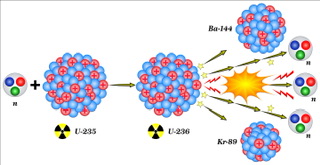We'll be back in a bit !
The system is currently undergoing a routine upgrade to ensure you get the best learning experience. The maintenance is expected to continue till 8:00 pm. Please check back later.
Thank you for your understanding!

The term "fission" is used to describe the splitting of a heavy nucleus into two roughly equal-sized lighter nuclei. The revelation that such an unusual nuclear reaction could occur marked the conclusion of a really spectacular event in the history of science, and it ushered in an era of intense and fruitful research.
The history of nuclear fusion began at the turn of the 20th century with research into how stars generate their own energy. As potential applications increased to include warfare, energy generation, and rocket propulsion, the field's emphasis broadened to include a comprehensive examination into the nature of matter and energy. In the 1930s, scientists, led by Hans Bethe, determined that nuclear fusion was the sun's energy source and that it was both theoretically and practically practicable.
Fission refers to the fragmentation of anything into smaller pieces. In this sense, nuclear fission refers to the splitting or fragmentation of a large atom into two or more smaller atoms. These little atoms are technically light in weight. Breakdown of the nuclear fission process releases large amounts of energy, proving that it is an exothermic process. The uranium fission process is described below.
Nuclear Fission Reaction
One kind of asexual reproduction known as fission occurs when a single organism divides into two or more pieces, each of which develops into a new organism. Whilst it is more prevalent in single-celled creatures like bacteria and protists, this process may also take place in multicellular organisms like sponges and some worms.
Fission is an easy procedure that doesn't put a lot of strain on the body. This method of reproduction is useful in situations where resources are few because it permits the population size of the organism to grow rapidly.
Fission is the dominant mode of reproduction in bacteria. As a bacterial cell splits in half, each daughter cell receives an exact replica of its mother's DNA. As the two cells divide, they each develop into a new, fully functional creature.
Fission is also prevalent in protists. As a protist cell splits, one daughter cell receives a greater share of the parent cell's genetic material. A new organism develops from the bigger half, while the smaller half may stay as a cyst or divide once again to produce two more.
Multicellular creatures that employ fission for reproduction include sponges and some worms. These creatures may divide their bodies into two or more sections, each of which develops into a separate living being.
Fission is an easy and effective method of reproduction, which thrives in low-supply settings. It's used by everything from bacteria to multicellular creatures because it helps them multiply rapidly.
Nuclear fission is a process in which a heavy nucleus splits into two or more lighter nuclei. This process releases a large amount of energy and is the basis of nuclear power plants. Examples of nuclear fission include the splitting of uranium-235 into two smaller nuclei, such as krypton-92 and barium-141, and the splitting of plutonium-239 into two smaller nuclei, such as uranium-235 and krypton-94. In both cases, the energy released is used to generate electricity.
Atomic fission releases energy in the form of thermalization when one atom is divided into two or more smaller atoms. Nuclear fission is the fundamental mechanism by which nuclear power plants generate electricity. The fission reaction releases heat, which is converted into electricity. As it generates almost no byproducts and no greenhouse emissions, fission energy is a green and efficient option. As fission energy may be utilised to create power even when other sources of energy are unavailable, it is another stable energy option.
Use of the fission process is significant in today's world.
Thermal energy for nuclear power plants is generated through nuclear fission. This heat is then used to turn water into steam, which is then used to power electrical generators.
About 21.5% of the electricity in the US comes from nuclear power plants. Nuclear fission employing uranium-235, which is also used in photographic sources, produces cesium-137 (Cs-137) and other rare radioisotopes. Nuclear fission energy can be used to power submarines and even some types of surface watercraft.
Radioactive isotopes created from nuclear fission are employed in many types of medical imaging and cancer treatment.
After combining at the sun's core, hydrogen nuclei release a tremendous amount of heat, which we feel as helium's presence on Earth.
An atom is split into two parts by a process known as nuclear fission, which is done to produce energy. The splitting of the uranium-235 nucleus when it is bombarded with neutrons is an important example of nuclear fission. On the other hand, it happens when two atoms combine and release energy. The name for this energy-producing process is nuclear fusion. This is how the Sun and other stars emit energy.
Frequently Asked Questions
Thorium outnumbers uranium in the natural world. It can only be used as a fuel when combined with a fissile substance, like reprocessed plutonium, because it is fertile rather than fissile on its own. Fissile uranium-233 can be produced using thorium fuels and employed in a variety of nuclear reactor designs.
To mitigate the dangers of fast-moving neutrons, a moderator is inserted into the nuclear reactor core. Forcing a nuclear chain reaction is much simplified by the inclusion of a moderator.
Fission happens when a neutron collides with an atom, causing it to become excited and divide into two smaller atoms (called fission products). Moreover, extra neutrons are released, which can set off a chain reaction. Each atomic fission results in the release of vast amounts of energy.
